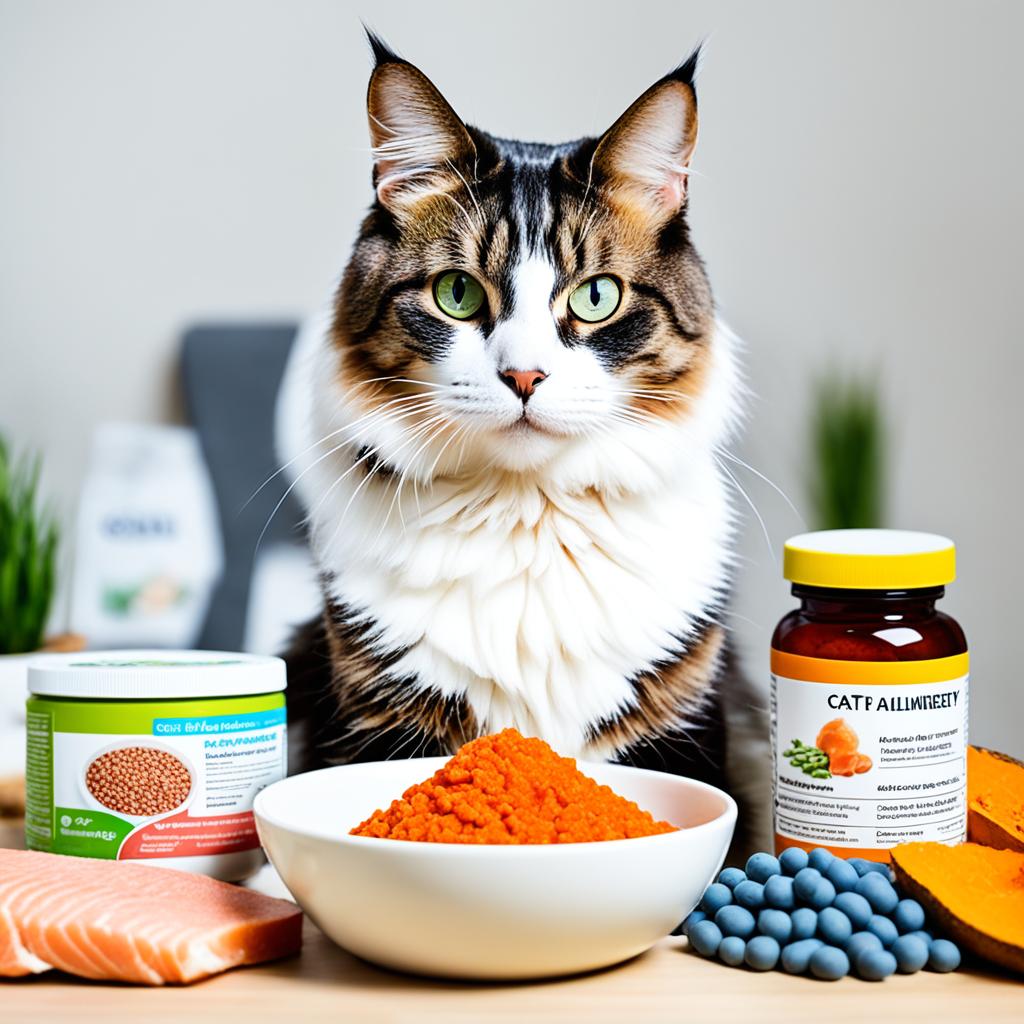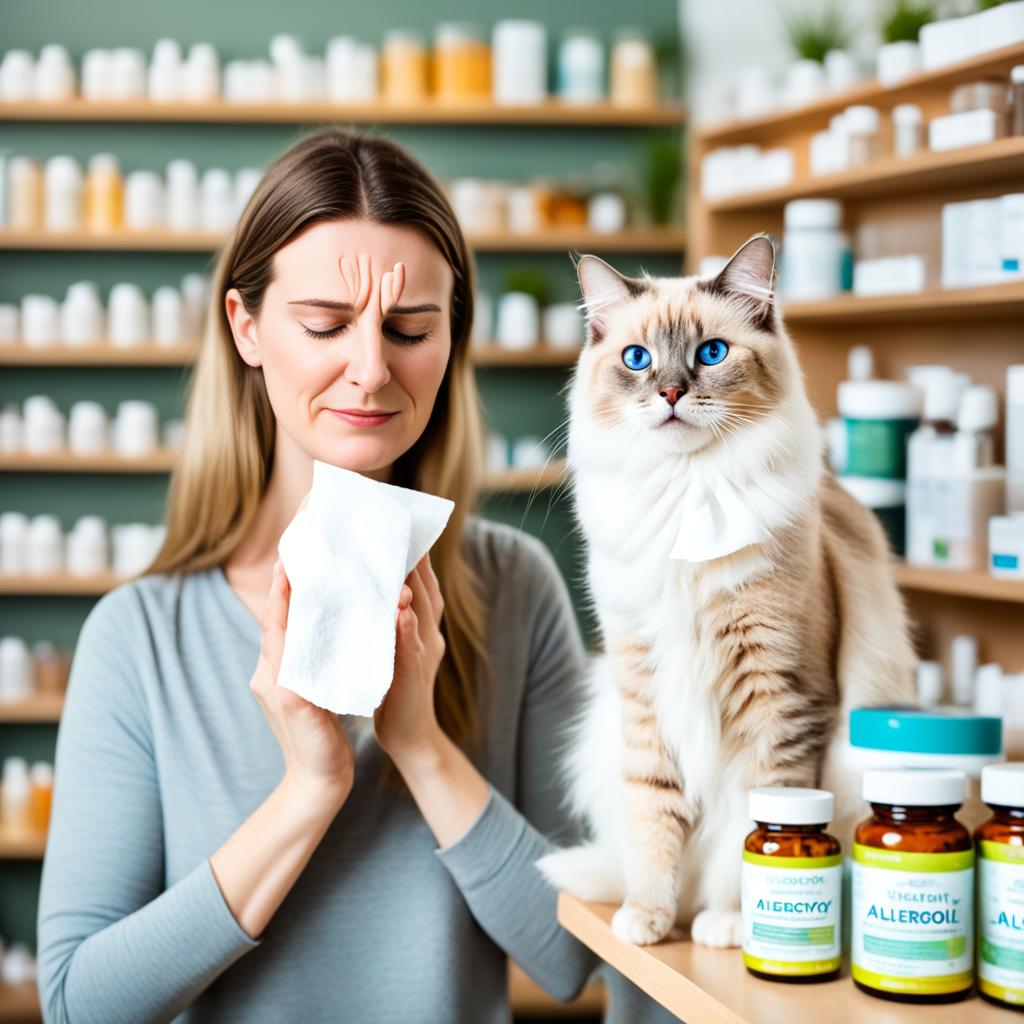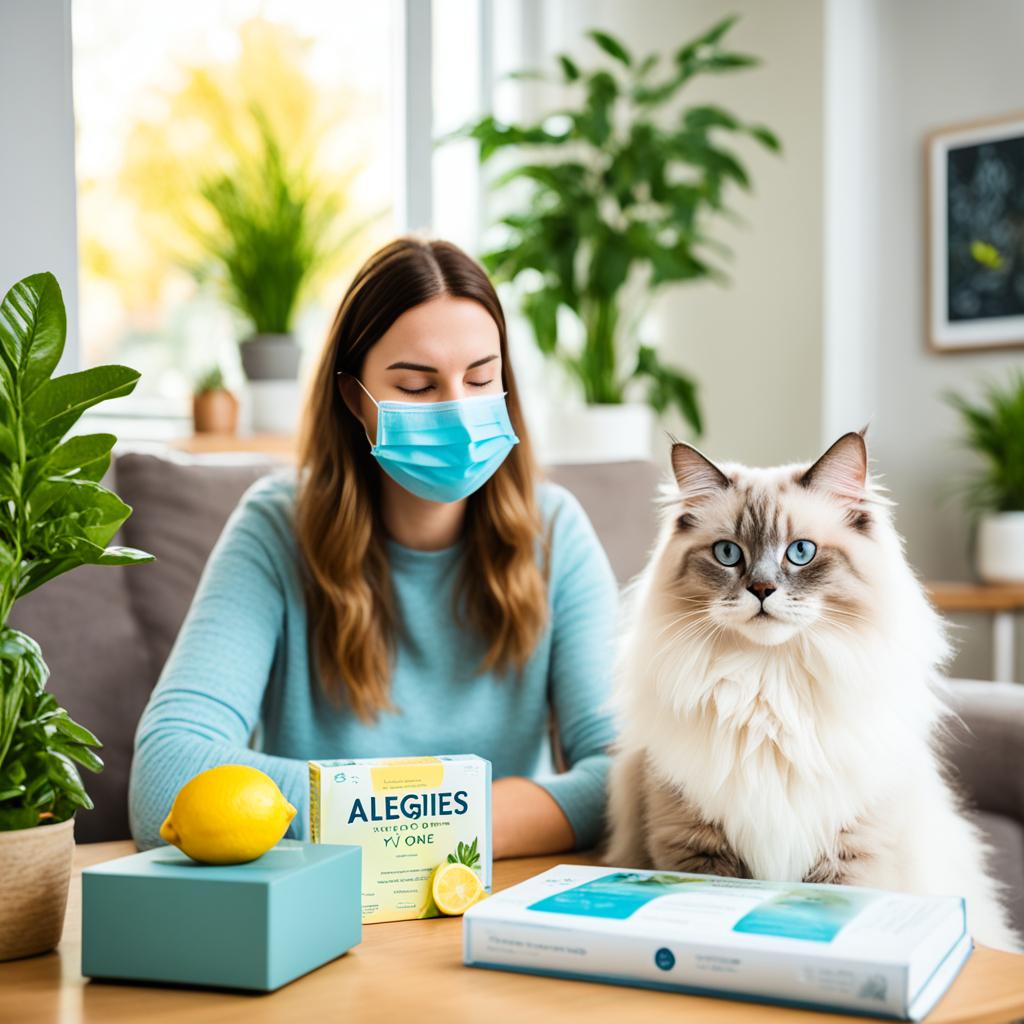Ever wondered about a cat breed that won’t make you sneeze endlessly? Ragdoll cats might just be the key, as Aunt Nicky and her friend Missy have shown. They lived easily with seven Ragdolls despite regular cat allergies. Is their fur special, or is it a myth about pet allergies?
Ragdolls are often considered hypoallergenic because they lack an undercoat. This undercoat is where most allergens hide. But be careful, Ragdolls still spread FEL d 1, the saliva protein that’s a common allergen. This protein sticks to their fur, turning their purrs into something that makes you want to sneeze. They may not cause as many reactions for some. Yet, they are not totally hypoallergenic because everybody reacts differently to them.
To enjoy a Ragdoll cat without the sneezing, keep your house super clean like Caymus and Murphy do. Minimizing allergen exposure is key. It lets you have fun with your Ragdoll without always being near a box of tissues.
Key Takeaways
- Ragdoll cats are often believed to be hypoallergenic due to their lack of an undercoat.
- Aunt Nicky and Missy successfully lived with seven Ragdolls despite cat allergies.
- Ragdolls still produce FEL d 1 protein in their saliva, a known allergen.
- Proper cleaning and minimizing exposure can help manage cat allergies.
- Personal reactions to Ragdolls can differ, making them not entirely hypoallergenic.
Understanding Ragdoll Cat Allergies

Some people think Ragdoll cats are hypoallergenic. But, a bit of science shows this isn’t true. Even though they don’t have an undercoat, they make the FEL d 1 Protein. This allergen is in their saliva, sticks to their fur, and floats in the air.
Not all Ragdolls are the same when it comes to making allergens. Dark-furred and unneutered male cats usually produce more. On the other hand, kittens may not shed as much, giving some hope. But, this doesn’t mean you’ll be allergy-free forever.
Being careful in how you care for your Ragdoll can ease allergy symptoms. Regular brushing removes allergens. Bathing them can also help. But, it’s not a complete fix for allergies.
The bottom line is the hypoallergenic idea about Ragdolls is a myth. They might not cause as many allergies as other cats, but they’re not allergy-proof. It all depends on the person. Taking steps to reduce allergens is key to living well with a Ragdoll.
The Role of Cat Saliva and Dander in Allergies

Ever sneeze a lot around cats? It’s because of their saliva and dander. These things can really mess with your immune system.
Why Cat Saliva is a Major Allergen
Cat saliva has a protein called FEL d 1. This protein spreads when a cat cleans itself, getting on the fur. Once on the fur, it can go everywhere in your home. So, managing cat allergies is quite a challenge. For people affected, it means sneezing a lot, having itchy eyes, and trouble breathing after being near cats, even for a short time.
Impact of Dander on Allergies
Ragdolls and some other breeds seem promising due to their lack of an undercoat. But, dander is still a big issue. Dander is tiny pieces of skin that stick to things like furniture or clothes. It’s very hard to avoid it in a home with a cat. Dealing with both cat dander and saliva is important for pet allergy relief. Even cats like Ragdolls, because they still produce dander, might trigger allergies in some people.
How to Deal with Ragdoll Cat Allergies?

Dealing with Ragdoll cat allergies might seem hard. But, with the right info and plans, it is doable.
Initial Steps to Take
First, talk to an allergist. They can help find your specific triggers. Tests with Ragdoll cats can show what you react to. Make a pet-free area, especially in your bedroom. This space will let you sleep without allergens.
Practical Home Solutions
Make your home a safe place from allergies with a few simple steps. Keep it clean regularly. HEPA air purifiers help remove allergens. Also, grooming your pet often can reduce loose hair and dander.
Nambudripad’s Allergy Elimination Techniques and Vitamin C instead of antihistamines work for some people. These options help attack allergies from different angles.
Using these pet allergy easy fixes can greatly improve how you live. You’ll be able to enjoy your cat more with less bother.
| Allergy-Friendly Home Solutions | Benefits |
|---|---|
| Regular Cleaning | Reduces allergen buildup |
| HEPA Air Purifiers | Cleanses air of allergens |
| Pet Grooming | Decreases loose hair and dander |
| Holistic Treatments | Offers alternative relief options |
By adding these cat allergy solutions to your daily life, you can handle allergic reactions well. This way, you can have a peaceful, allergy-safe home.
Creating an Allergy-Friendly Home Environment

Making your home safe from allergens is key for everyone’s well-being, especially if pet allergies are a concern. Keeping things clean with a focus on reducing allergens can boost the quality of the air inside your home.
Regular Cleaning Techniques
To have an allergy-friendly home, you must clean diligently. Use a vacuum with a HEPA filter to get rid of dust and tiny particles. Also, use special shampoos on pets to lessen allergens they might spread.
Clean bedding and pet items in hot water to remove allergens even more. Target high-touch areas when cleaning and keep some places, like the bedroom, free of pets to reduce allergen levels there.
Air Purifiers and Filters
Air purifiers with HEPA filters are excellent for owners of pets that cause allergies. They remove allergens from the air, making it cleaner. Put them in areas your pets like to stay in most.
Sticking to these cleaning and air-purifying methods will create a better environment for those with allergies. It will make your home a cleaner and more comfortable place for everyone.
Nutritional Management for Cats with Allergies

Did you know changing your cat’s food can quickly reduce allergies? Switching to a hypoallergenic cat food could be just what your cat needs. These foods have fewer ingredients that might cause allergies.
First, learn what to avoid. Things like corn, wheat, and soy are often the culprits. Choose natural remedies with simple, healthy ingredients. This can reduce allergies and keep your cat healthy.
Below is a table to help you pick the right hypoallergenic cat food:
| Brand | Key Features | Common Allergens Excluded |
|---|---|---|
| Hill’s Prescription Diet | Veterinary Formulated, Limited Ingredients | Corn, Soy, Dairy |
| Blue Buffalo Basics | Natural Ingredients, Easy to Digest | Gluten, Poultry, Eggs |
| Natural Balance L.I.D. | Grain-Free, Single Animal Protein | Grains, common animal proteins |
Choosing an allergic cats diet with natural remedies is great. Pick foods with pure, unprocessed ingredients. Research shows such diets can lower allergy symptoms in cats.
So, the right diet changes can make a big difference. This is key to helping your cat live well without allergies.
Best Hypoallergenic Cat Breeds Besides Ragdolls

For those very sensitive to cat allergens, the right hypoallergenic cat breed is key. There are other breeds besides Ragdolls that are better for allergy sufferers. Let’s look at some top picks.
Siberian Cats
Siberian Cats are a top choice for people with allergies. They produce less of the FEL d 1 protein, which causes allergies. These cats have beautiful, thick coats and are very friendly. Many people don’t react as much to them, even with their fur.
Meeting a Siberian cat before deciding can help. This allows you to see if they trigger your allergies. Remember, no cat is completely hypoallergenic, but Siberians are a good option for many.
Balinese Cats
Balinese Cats are another great choice for those with allergies. They, too, produce low levels of the FEL d 1 allergen. Often called the long-haired Siamese, they have a stunning look with silky fur and blue eyes.
| Breed | Characteristic | Allergen Level | Caring Tips |
|---|---|---|---|
| Siberian | Thick fur, friendly | Lower FEL d 1 | Regular grooming, air purification |
| Balinese | Long-haired, blue eyes | Lower FEL d 1 | Frequent brushing, hypoallergenic wipes |
Just like with Siberian cats, meeting Balinese cats first is smart. This helps you determine if they are a good fit for your allergies. Choosing the right breed is important for a happy and healthy pet experience.
Natural Supplements to Alleviate Allergies in Cats

Natural supplements are great for easing your cat’s allergies. They’re herbal and blend well with your cat’s body. This helps to calm your cat’s allergy symptoms.
Herbs and Natural Remedies
Herbs like eyebright, feverfew, sweet goldenrod, and ginger are very helpful. They reduce allergic reactions because they reduce inflammation. NHV Natural Pet Products use these ingredients to keep your cat healthy.
Proper Administration of Supplements
Using supplements safely is key. Dosage depends on your cat’s weight. It’s smart to talk with your vet to make a plan. This way, your cat gets safe and effective allergy care.
Managing Allergy Symptoms in Humans

Living with cats can mean dealing with allergy symptoms. If you suffer from allergies, whether at certain times of the year or all year long, you must know how to reduce these symptoms. There are effective ways to lessen your discomfort.
Vitamin C Megadoses
Have you considered Vitamin C for your allergies? This vitamin, famous for fighting colds, can also help with allergies. In large amounts, Vitamin C works like a natural antihistamine, decreasing allergy symptoms’ impact. Taking more Vitamin C could significantly change how you manage your allergies.
Allergen Immunotherapy (Allergy Shots)
If you don’t like taking pills, think about Immunotherapy. Allergy shots offer a method to make your body accept cat allergens over time. This includes FEL d 1, an allergen in cat saliva. While it takes time, immunotherapy is a proven method for lasting allergy management.
“With enough Vitamin C and a good immunotherapy plan, you might just find yourself cuddling up with your feline friend rather than sneezing from across the room.”
Utilizing these techniques can bring big relief. You’ll find you can be around your pets more without the constant sneezing and itchiness. Make these approaches part of your plan to see significant changes in how you deal with allergies.
Lifestyle Adjustments for Pet Owners with Allergies

Living comfortably with a pet, even if you’re allergic, is possible. It requires some lifestyle adjustments. With a few changes, you can have a cozy, clean home that’s good for both you and your pet.
Start with your pet’s grooming. Regular grooming cuts down on allergens. For those with daily pet contact, this step is crucial. Use hypoallergenic shampoos and tools for best results.
Next, think about your personal care items. Switching to hypoallergenic products can be a game-changer. Changing your shampoo or soap might surprise you with how much it helps.
Keeping your home clean is also vital for managing pet allergies. Regular cleaning reduces allergen buildup. Vacuum often, wash bedding in hot water, and don’t miss hidden spots where pet hair collects.
Consider changing your home’s design to be more allergy-friendly. Materials like hardwood and leather are better than carpet or fabric for trapping allergens. Choose furniture and flooring that are easy to clean.
| Aspect | Adjustment | Benefit |
|---|---|---|
| Grooming | Regular pet grooming | Reduces allergens |
| Personal Care | Hypoallergenic products | Low allergen exposure |
| Cleanliness | Frequent cleaning | Minimizes triggers |
| Home Design | Easy-to-clean materials | Less allergen buildup |
Making these changes can greatly improve life with pets and allergies. It’s about making smart choices and simple adjustments. This leads to a healthier, more comfortable home for everyone.
Conclusion
Living with a Ragdoll cat is fun, even though they’re not hypoallergenic. You just have to work a bit harder to deal with allergies. The key is to know what sets off your allergies and to have a plan for it.
This involves keeping your home clean, using air purifiers, and maybe trying out allergen shots. These steps make your living space better for both you and your pet.
You should also make changes in your life and consider medicine to fight off cat allergens. Yes, your Ragdoll may still cause some allergies. But, smart choices and regular care can cut down on the sneezing and itching.
It’s wise to talk to doctors for advice. They can help you figure out how to manage your allergies. With the right plan, you and your Ragdoll can live happily together, sneeze-free. Enjoy the adventure of having a pet and stay on top of your allergy game!




